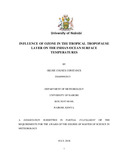| dc.description.abstract | This study sought to investigate the distribution of ozone and temperature within the tropical tropopause layer and the linkages of ozone variability at the Chemopause level to sea surface temperature in Indian Ocean using ozonesonde data. The ozonesonde data sets were acquired from World Ozone and Ultra Violet radiation Data Center, Montreal, Canada and Southern Hemisphere Additional Data Ozonesonde while sea surface temperature (SST) data was obtained from the Hadley Centre hosted at United Kingdom Meteorological Office. Calculation of monthly and seasonal arithmetic mean, Potential temperature gradient, correlation, regression and multiplicative shift methods were used to realize the objectives of the study.
Mean monthly and seasonal ambient air temperature, potential temperature gradient change with geopotential height, and vertical ozone mixing ratios were computed over Watukosek, Nairobi, Sepang and Malindi. Gridded SST data were extracted from three Indian Ocean regions namely; 60°E-70°E, 3°N-20°N; 55°E-60°E°, 33°S-26°S and 30°E-60°0E, 44°-40°S which were considered relevant for the forecast of seasonal rainfall over Kenya. The data sets were subjected to correlation and regression to establish relationship between Ozone and ambient temperature at chemopause level. The result was then subjected to a statistical significance test at 95% confidence level with two degrees of freedom using student t_test statistic. The main convective out flow leve for Watukosek, Nairobi, Sepang and Malindi was found to be at 13.6, 13.4, 14.0 and 13.7 km, respectively, above sea level. Cold point temperature tropopause was 16.6km for Watukosek, 17.2km for Nairobi, 18.2km for Sepang and 16.8 km for Malindi. The seasonal variability of ozone was found to be compact in the troposphere and slight variability in the tropopause layer. There were marked fluctuations of ozone in the stratosphere. The months of December, January and February had the lowest ozone mixing ratios in the troposphere while June, July and August exhibited the highest ozone mixing ratios over Nairobi and Sepang.
It may be concluded that there is strong influence of SSTs at locations 60°E-70°E, 3°N-20°N, 55°E-60°E°, 33°S-26°S and 30°E-60°0E, 44°-40°S in Indian ocean to Nairobi equatorial continental ozone mixing ratios variability at 14.9km. Therefore, O3 mixing ratios may be used to predict seasonal weather/climate with a lead time of four months instead of SSTs over Kenya. | en_US |

